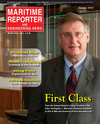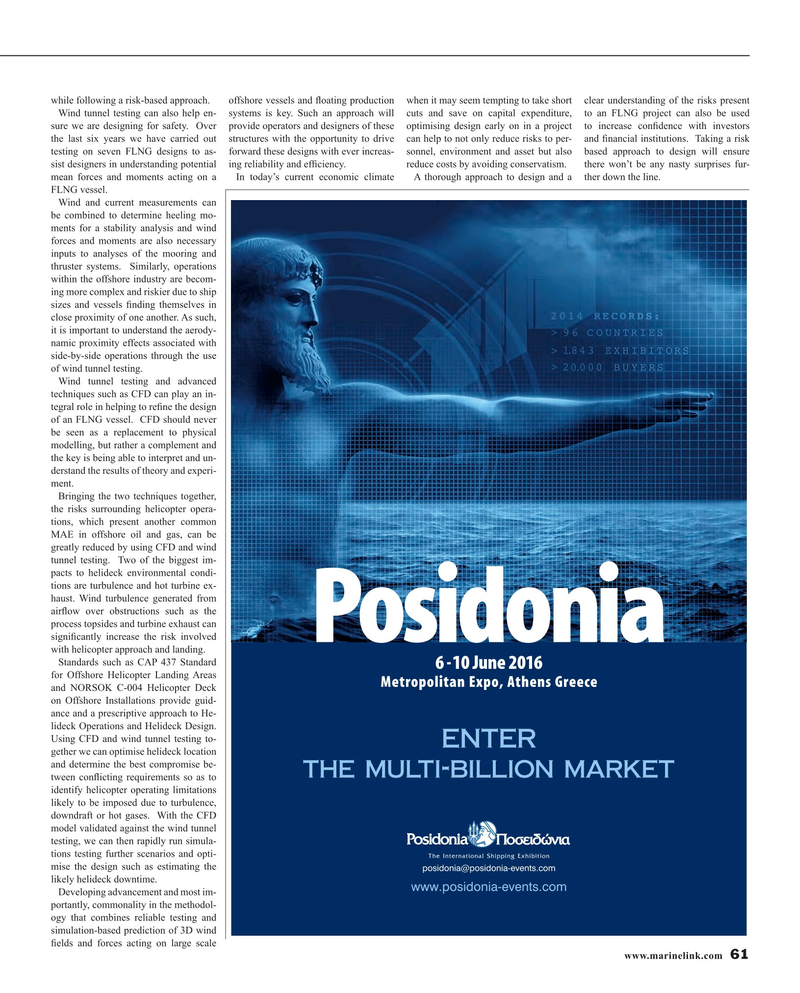
Page 61: of Maritime Reporter Magazine (October 2015)
Marine Design Annual
Read this page in Pdf, Flash or Html5 edition of October 2015 Maritime Reporter Magazine
while following a risk-based approach. offshore vessels and ? oating production when it may seem tempting to take short clear understanding of the risks present
Wind tunnel testing can also help en- systems is key. Such an approach will cuts and save on capital expenditure, to an FLNG project can also be used sure we are designing for safety. Over provide operators and designers of these optimising design early on in a project to increase con? dence with investors the last six years we have carried out structures with the opportunity to drive can help to not only reduce risks to per- and ? nancial institutions. Taking a risk testing on seven FLNG designs to as- forward these designs with ever increas- sonnel, environment and asset but also based approach to design will ensure sist designers in understanding potential ing reliability and ef? ciency. reduce costs by avoiding conservatism. there won’t be any nasty surprises fur- mean forces and moments acting on a In today’s current economic climate A thorough approach to design and a ther down the line.
FLNG vessel.
Wind and current measurements can be combined to determine heeling mo- ments for a stability analysis and wind forces and moments are also necessary inputs to analyses of the mooring and thruster systems. Similarly, operations within the offshore industry are becom- ing more complex and riskier due to ship sizes and vessels ? nding themselves in close proximity of one another. As such, it is important to understand the aerody- namic proximity effects associated with side-by-side operations through the use of wind tunnel testing.
Wind tunnel testing and advanced techniques such as CFD can play an in- tegral role in helping to re? ne the design of an FLNG vessel. CFD should never be seen as a replacement to physical modelling, but rather a complement and the key is being able to interpret and un- derstand the results of theory and experi- ment.
Bringing the two techniques together, the risks surrounding helicopter opera- tions, which present another common
MAE in offshore oil and gas, can be greatly reduced by using CFD and wind tunnel testing. Two of the biggest im- pacts to helideck environmental condi- tions are turbulence and hot turbine ex- haust. Wind turbulence generated from air? ow over obstructions such as the process topsides and turbine exhaust can signi? cantly increase the risk involved
Posidonia with helicopter approach and landing.
Standards such as CAP 437 Standard 6-10 June 2016 for Offshore Helicopter Landing Areas
Metropolitan Expo, Athens Greece and NORSOK C-004 Helicopter Deck on Offshore Installations provide guid- ance and a prescriptive approach to He- lideck Operations and Helideck Design.
Using CFD and wind tunnel testing to- enter gether we can optimise helideck location and determine the best compromise be- the multi-billion market tween con? icting requirements so as to identify helicopter operating limitations likely to be imposed due to turbulence, downdraft or hot gases. With the CFD model validated against the wind tunnel testing, we can then rapidly run simula- tions testing further scenarios and opti-
The International Shipping Exhibition mise the design such as estimating the [email protected] likely helideck downtime. www.posidonia-events.com
Developing advancement and most im- portantly, commonality in the methodol- ogy that combines reliable testing and simulation-based prediction of 3D wind ? elds and forces acting on large scale www.marinelink.com 61
MR #10 (58-65).indd 61 10/2/2015 11:47:13 AM

 60
60

 62
62
